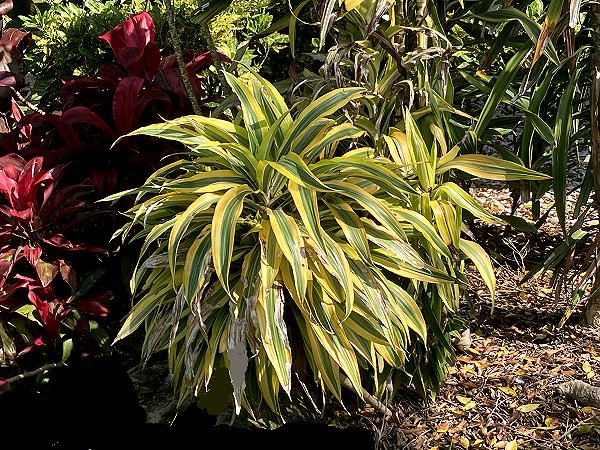"Magnolia Blossom." The eight magnolia trees continue to produce flowers,
usually one at a time, and each flower lasts for two days and then turns brown.
"Japanese Fern Tree." This is a handsome decorative tree. It never needs trimming,
and takes this form naturally.
"Philodendron Rojo Congo." The philodendron comes in many sizes and shapes
and colors. This one has dark red stalks, like rhubarb, and dark, dramatic looking leaves.
"Coral Mussaenda." The bush is covered with these large clusters of
colorful petals.
Outside one of the doors over at Cypress Bend, I found this nice mixture of
different colors of Bromeliads.
"Carissa Multiflora." The very dark green shiny foliage makes a dramatic
backdrop for the pure white flowers.
"White Candles / Whitfieldia Elongata."
"White Candles"
"White Crepe Myrtle" in front and "Royal Poinciana" in orange at back.
These are in George Brummer Park, where I frequently stop and rest on my walks.
Clusters of "White Crepe Myrtle" blossoms.
"Sanchezia" is a very attractive green bush. It comes in many varieties of
patters and shades of green.
"Yucca" plan in bloom.
"Broad Leaf Lady Palm." This comes in many varieties and sizes.
"Yellow Alder / Jamaican Ramgoat Dashalong"
"Split-leaf Philodendron," one of the hundreds of kinds of philodendron.
A hedge of "Pink Ixora."
A young "Queen Crepe Myrtle"
Close-up of "Queen Crepe Myrtle" blossoms. Entire trees are covered in these
beautiful purple flowers.
The "Golden Showers" tree bloomed before it had any leaves. As the leaves appeared,
the golden petals of the flowers dropped off. But now something unusual has
happened; the tree is sending out more golden showers of petals along with the
green leaves. I enjoy watching it.
"Angus" Agave. The Agave plants come in many sizes and colors, so they are very
handy in creating interesting landscapes. This large Agave has many stripes on it.
This plant could not be used to make tequila, which is produced only from the Blue Weber
Agave, which grows at a high altitude. But this and all other agaves can be used to
make mescal, which is also a nice alcoholic drink.































































